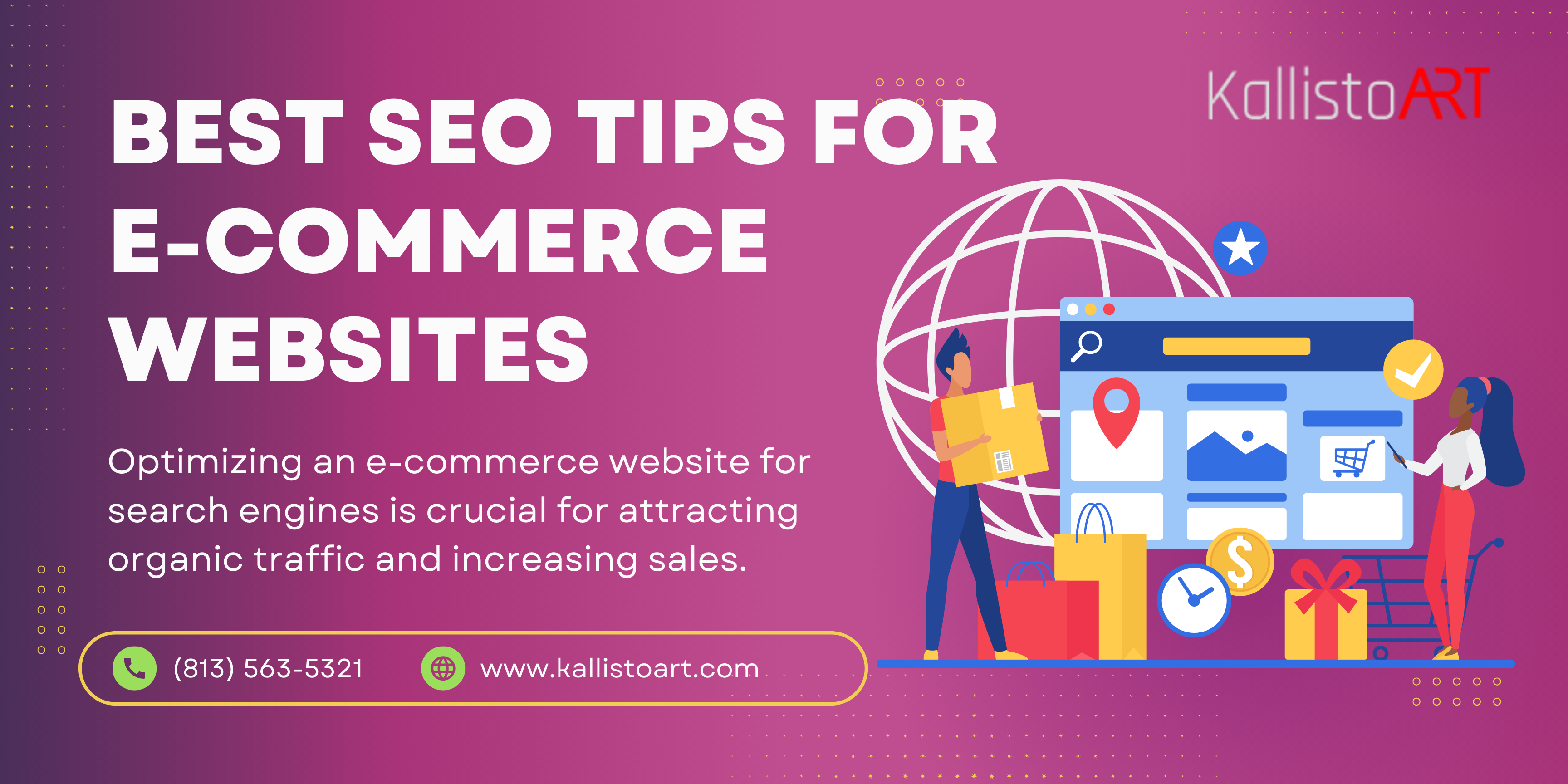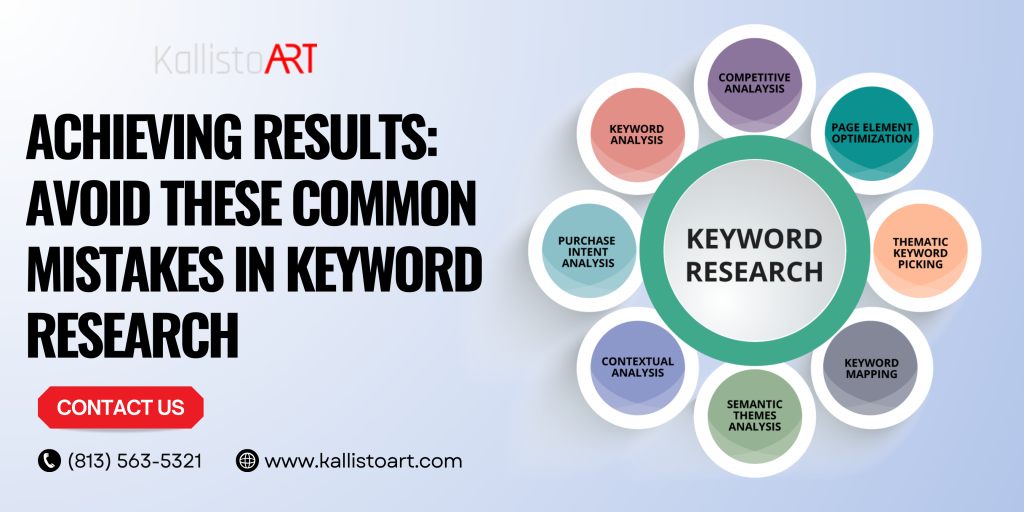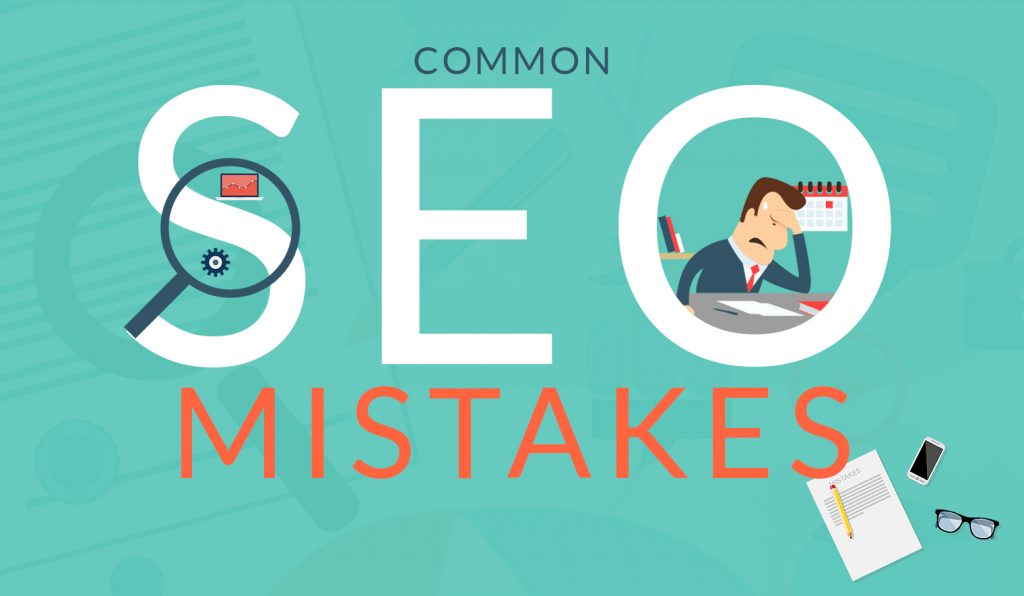
Best SEO Tips for E-commerce Website – KallistoArt
Introduction
In the ever-evolving landscape of online commerce, the success of an E-commerce website hinges on its visibility in search engine results. To navigate this digital terrain effectively, businesses turn to the expertise of SEO service providers. In this guide, we unravel the key strategies and insights that make KallistoArt stand out as the best SEO service company in Tampa, Florida. As we delve into the realm of optimizing E-commerce websites, you’ll discover the invaluable tips and techniques that set KallistoArt apart, ensuring your online store not only ranks higher but flourishes in the competitive online marketplace.
Importance of SEO for E-commerce
In the ever-evolving digital landscape, the significance of Search Engine Optimization (SEO) cannot be overstated, particularly for e-commerce websites. Here’s a detailed exploration of why SEO is paramount for the success of your online store:
1. Enhanced Visibility and Traffic
At the core of SEO lies the objective to improve your website’s visibility on search engine results pages (SERPs). When potential customers search for products or services that align with what you offer, a well-optimized e-commerce site is more likely to appear prominently. This increased visibility translates directly into more organic traffic, allowing your products to reach a broader audience.
2. Credibility and Trust Building
In the crowded e-commerce space, credibility is a currency that can significantly impact consumer behavior. Appearing on the first page of search results signals to users that your website is relevant, reliable, and authoritative. Users are more likely to trust and engage with websites that rank higher, fostering a sense of credibility that can influence purchasing decisions.
3. Cost-Effective Marketing Strategy
Compared to paid advertising, SEO offers a cost-effective, sustainable marketing strategy. While paid campaigns can deliver immediate results, they come with ongoing costs. On the other hand, the long-term benefits of SEO endure without continuous investment. Once your e-commerce site establishes a strong SEO foundation, it can attract organic traffic consistently, minimizing the need for extensive paid promotions.
4. Improved User Experience
SEO isn’t just about appeasing search engine algorithms; it’s about creating a seamless, user-friendly experience. Search engines reward websites that prioritize user experience, and this aligns with the goals of e-commerce platforms. Optimizing your site structure, improving page load times, and ensuring mobile responsiveness not only please search engines but also enhance the overall experience for your visitors, potentially increasing conversions.
5. Competitive Edge in the Market
In the competitive world of e-commerce, staying ahead of rivals is essential. An effective SEO strategy can give you a competitive edge by ensuring your products are discoverable when consumers are actively searching. By analyzing competitor strategies, identifying valuable keywords, and consistently optimizing your content, you position your e-commerce site as a formidable player in your niche.
6. Adaptability to Evolving Trends
The digital landscape is dynamic, with search engine algorithms, user behaviors, and technology constantly evolving. SEO necessitates a proactive approach, requiring you to stay abreast of industry trends and adapt your strategies accordingly. This adaptability ensures that your e-commerce site remains relevant and visible amidst changing online dynamics.
Foundation of E-commerce SEO
Keyword Research
Identifying Target Keywords
Keyword research is the cornerstone of any successful SEO strategy. Start by understanding the words and phrases your potential customers are using to search for products similar to yours. Tools such as Google Keyword Planner, SEMrush, or Ahrefs can assist in uncovering high-impact keywords with substantial search volumes.
Dig into the specific terms related to your products, considering both broad and specific keywords. For example, if you’re selling handmade leather wallets, keywords like “handmade leather goods” or “artisan wallets” might be relevant.
Long-tail Keywords for Product Pages
While targeting broad keywords is essential, don’t underestimate the power of long-tail keywords. These are more specific, detailed phrases that potential customers might use when they’re close to making a purchase decision. Long-tail keywords often have lower search volumes, but they tend to convert better.
For our leather wallet example, long-tail keywords could include phrases like “handmade leather wallet with coin pocket” or “slim artisan wallets for men.” Incorporate these long-tail keywords naturally into your product descriptions and other content.
Optimize Your E-commerce Success with KallistoArt – Your Trusted Partner for the Best SEO Services in Tampa, Florida! Elevate Your Online Presence Now!
Competitor Analysis
Analyzing Competitor SEO Strategies
Analyzing your competitors’ SEO strategies can provide valuable insights. Identify who your main competitors are and scrutinize their online presence. Tools like SEMrush or Moz can help you discover the keywords they’re ranking for, their backlink profile, and the content that resonates with their audience.
By understanding what works for your competitors, you can tailor your approach. If a competitor is successful with certain keywords, consider whether those keywords align with your products and audience.
Identifying Competitive Keywords
While it’s crucial to target keywords relevant to your products, also look for opportunities your competitors might be overlooking. Identify niche keywords or long-tail variations that might have lower competition but are still relevant to your audience.
Tools like SEMrush often provide a list of “related” or “phrase match” keywords, which can be a goldmine for discovering untapped opportunities. By strategically targeting these keywords, you can capture valuable traffic that your competitors might be missing.
On-Page SEO
Optimizing Product Descriptions
Crafting compelling product descriptions is not only about showcasing your products but also optimizing for relevant keywords. Each product page should have a unique and informative description that includes target keywords naturally.
Highlight the key features and benefits of your products, ensuring that the language is user-friendly. Avoid keyword stuffing, as this can harm both user experience and SEO. Instead, focus on creating engaging, informative content that encourages visitors to make a purchase.
SEO-friendly URLs and Meta Tags
Optimizing URLs and meta tags is a fundamental aspect of on-page SEO. Ensure that your product URLs are concise and include relevant keywords. For example, instead of a generic URL like “yourstore.com/product123,” use “yourstore.com/handmade-leather-wallet.”
Technical SEO for E-commerce
Technical SEO is the backbone of your e-commerce website’s search engine performance. It involves optimizing various technical aspects to ensure that search engines can crawl, index, and understand your site efficiently. Here’s a closer look at key technical considerations for e-commerce SEO:
I. Site Structure
1. Organizing Categories and Subcategories
An organized site structure is crucial for both users and search engines. Create a logical hierarchy for your product categories and subcategories. This not only enhances user experience but also makes it easier for search engine crawlers to navigate and index your pages.
Tip: Use clear and descriptive category names, and avoid creating too many levels of subcategories to prevent confusion.
2. Implementing Breadcrumbs
Breadcrumbs provide users with a clear path back to previous pages and help search engines understand the relationship between different pages on your site. Implementing breadcrumbs enhances navigation and contributes to a better user experience.
Tip: Ensure that your breadcrumbs reflect the hierarchy of your site and use structured data markup for search engines to interpret them correctly.
II. Mobile Optimization
1. Responsive Design
With a growing number of users accessing the internet via mobile devices, a responsive design is essential. Ensure that your e-commerce site is mobile-friendly, adapting seamlessly to various screen sizes. Google prioritizes mobile-friendly websites in its rankings, making this an integral aspect of technical SEO.
Tip: Test your site’s mobile responsiveness using tools like Google’s Mobile-Friendly Test to identify and fix any issues.
2. Accelerated Mobile Pages (AMP)
Consider implementing Accelerated Mobile Pages (AMP) for your product pages. AMP is a Google-backed project that creates lightweight versions of web pages, loading them faster on mobile devices. Faster page load times contribute to a positive user experience and can positively impact SEO.
Tip: Prioritize AMP implementation for key product pages to provide a faster and smoother browsing experience for mobile users.
III. Page Speed Optimization
1. Compressing Images
Large image files can significantly slow down your website. Compress images without compromising quality to reduce page load times. Optimized images not only improve user experience but also contribute to higher search engine rankings.
Tip: Use image compression tools and consider lazy loading images to ensure they load only when they come into the user’s viewport.
2. Browser Caching
Implement browser caching to reduce server load and improve page load times for returning visitors. Caching allows browsers to store static files locally, reducing the need to download them with each visit.
Tip: Configure caching settings based on the frequency of updates to your website content to strike a balance between performance and freshness.
Content Creation Strategies
1. Creating Informative Blog Posts
- Exploring Relevant Topics:
- Identify topics that align with the products or services offered.
- Address customer pain points, common queries, or emerging trends in the industry.
- Conduct keyword research to discover high-search-volume and low-competition topics.
- Providing In-Depth Insights:
- Offer comprehensive and valuable information in your blog posts.
- Dive deep into subjects, providing insights that go beyond surface-level content.
- Establish the blog as a go-to resource for industry knowledge.
- Incorporating Keyword-Rich Content:
- Integrate relevant keywords naturally into the content.
- Focus on long-tail keywords to target specific search queries.
- Optimize meta titles and descriptions for each blog post.
2. Internal Linking Strategies
- Implementing Contextual Links:
- Integrate internal links within the blog content where contextually relevant.
- Link to related blog posts, product pages, or other valuable resources.
- Enhance user experience by providing additional information.
- Distributing Link Equity:
- Distribute link equity throughout the website by linking to important pages.
- Improve the SEO performance of product pages by linking from authoritative blog posts.
- Ensure a balanced distribution of internal links for optimal SEO impact.
Product Content Optimization
1. High-Quality Product Images
- Utilize High-Resolution Imagery:
- Display products with clear, high-resolution images that allow customers to examine details.
- Invest in professional product photography to showcase items in the best light.
- Image Optimization for SEO:
- Optimize Image File Names: Use descriptive file names that include relevant keywords.
- Alt Text Optimization: Write concise and informative alt text for images, incorporating keywords where appropriate.
- Image Compression: Copress images to maintain optimal page loading speed withou mcopmormising quality.
2. Compelling Product Destcriptions
- Uniqueness and Persuasion:
- Craft Unique Descriptions: Avoid using generic manufacturer descriptions; create original content that sets your products apart.
- Persuasive Copywriting: Use persuasive language to highlight product benefits and encourage conversions.
- Keyword Integration:
- Strategic Keyword Placement: Incorporate relevant keywords naturally within product descriptions for SEO benefits.
- Long-Tail Keywords: Include long-tail keywords to capture specific search queries and attract targeted traffic.
Optimize Your E-commerce Success with KallistoArt – Your Trusted Partner for the Best SEO Services in Tampa, Florida! Elevate Your Online Presence Now!
User Experience and SEO
A. Responsive Design
- Enhancing Mobile User Experience
- Discuss the importance of mobile optimization for e-commerce websites.
- Highlight the significance of responsive design in ensuring a seamless experience across various devices.
- Mention mobile-friendly design elements, such as touch-friendly buttons and easy navigation.
- User-friendly Navigation
- Explore the role of intuitive navigation in user satisfaction and SEO.
- Discuss strategies for creating clear and concise navigation menus.
- Emphasize the importance of reducing the number of clicks to reach product pages.
B. Decreasing Bounce Rate
- Improving Page Load Times
- Explain how page speed impacts bounce rates and SEO rankings.
- Provide tips for optimizing images, utilizing browser caching, and minimizing scripts for faster loading times.
- Highlight tools and techniques for assessing and improving page speed.
- Engaging Call-to-Action Buttons
- Discuss the significance of compelling CTAs in retaining visitors.
- Provide examples of effective call-to-action buttons for e-commerce sites.
- Emphasize the need for clarity, urgency, and relevance in CTAs to encourage user interaction.
Conclusion
In the dynamic world of E-commerce, the significance of a robust SEO strategy cannot be overstated. KallistoArt, the preeminent SEO service company in Tampa, Florida, emerges as the beacon guiding businesses through the complexities of online visibility. From leveraging cutting-edge techniques to an unwavering commitment to client success, KallistoArt’s expertise transcends conventional norms. As you embark on the journey to optimize your E-commerce website, trust in the proven strategies and personalized approach that sets KallistoArt apart in the realm of SEO excellence. Elevate your online presence, secure higher rankings, and ultimately, transform casual visitors into loyal customers with KallistoArt – where unparalleled SEO meets the unique needs of your E-commerce venture.
FAQs
Common Questions About E-commerce SEO
Q: How long does it take to see results from SEO efforts?
A: SEO is a gradual process, and the timeline for results can vary. Generally, expect to see improvements within a few months, with more significant gains over time.
Q: Is social media important for e-commerce SEO?
A: Yes, social signals can impact SEO. Integrating social media into your strategy enhances brand visibility and can indirectly influence search engine rankings.

 Previous Post
Previous Post Next Post
Next Post


